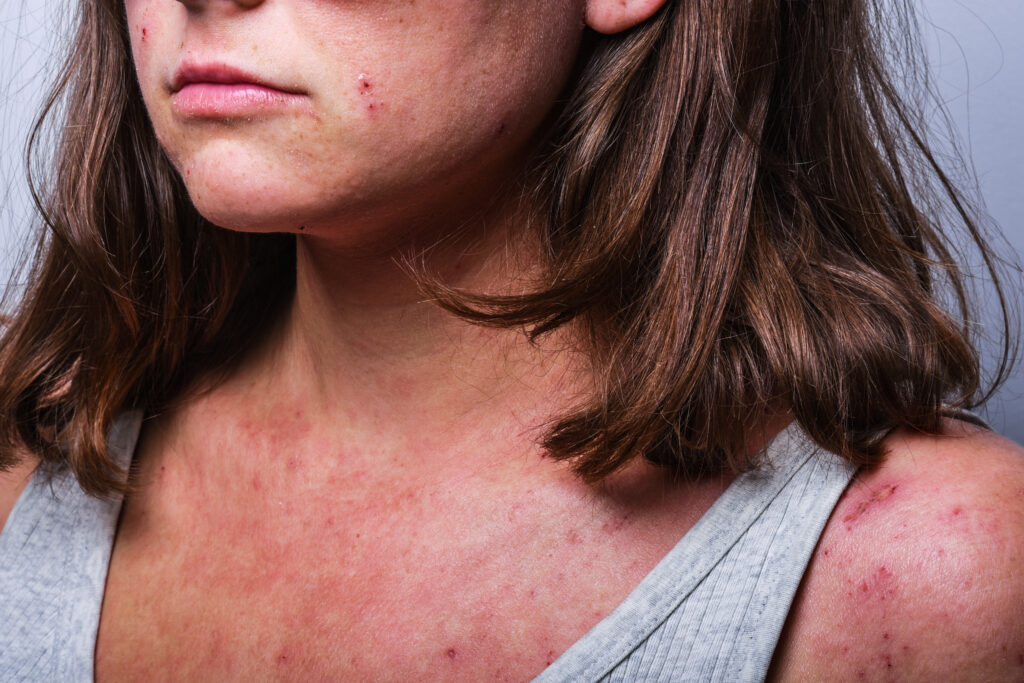
Dermatitis can develop on any area of the body and at any age. It often starts in early childhood. Rashes may ooze clear fluid or bleed. The itching is intense. Scratching can make the rash worse.
A rash called atopic dermatitis is the most common type of eczema. It begins with itchy skin that gets scaly and thick.
Redness
Skin redness is the most common symptom and can be the first sign that something is wrong. If you have a red face that doesn’t go away, it might mean you need to see a dermatologist.
Redness can look like a sunburn that won’t fade or a rash you got after taking new medication. It can also be the sign of a condition like psoriasis, or a more serious problem like dermatitis.
Rashes often resemble red, itchy, swollen patches of skin and may have small bumps on them. Some, like poison ivy, come and go without a clear cause, but others like contact dermatitis form over several days or after exposure to an irritant such as fabric, detergents, chemicals, or pets.
Other types of dermatitis are permanent, such as spider veins (little purple or red web-like lines on your legs that show up when the tiny blood vessels right under the surface break) and cellulitis (a serious infection in deeper layers of tissue). The best way to know what’s causing your redness is to talk to your doctor or dermatologist.
Scaling
Dermatitis can cause your skin to itch, crack, ooze or flake. It can be mild or severe and it may come and go. There are several different types of dermatitis including atopic eczema (eczema), contact dermatitis and seborrheic dermatitis.
Atopic dermatitis -- or eczema -- is the most common type. It appears all over the body, but it often shows up on the face, hands or feet. It's itchy and scaly, and the rash often forms blisters that ooze and crust over. Scratching can make the rash worse.
Other types of dermatitis include dyshidrotic dermatitis, which causes itchy and blistered areas on the palms of your hands and soles of your feet. It's caused by a specific trigger and affects more men than women. Stasis dermatitis is related to circulatory problems and can appear as circular areas of scaly, itchy skin on the lower legs. It can also bleed easily when scratched.
Itching
The most common sign of dermatitis is itching. It can happen in just one part of your body, or on several parts. It may also get worse at night, which can make it harder to sleep. The itching of dermatitis is often described as an uncomfortable feeling or an irritating tingling.
Eczema (atopic dermatitis): This is the most common type of dermatitis. It causes patches of skin to become red, scaly, itchy and sometimes flaky or crusted over. Sometimes tiny blisters that contain clear fluid form and can weep.
Discoid eczema: This type of dermatitis causes circular patches to appear on the palms of the hands and the soles of the feet. These patches can be dry, scaly and itchy. Sometimes these patches are covered with thick, painful, scabby toenails or swollen and tender ankles.
Talk to your healthcare provider about what triggers your itching. Avoid things that make it worse, like hot showers and baths or soaps with harsh chemicals. Moisturize your skin after you shower or bathe, and use a steroid cream or ointment that your doctor prescribes for you. Take antihistamine medicines by mouth to help control severe itching.
Weeping
The itchy, scaly skin of dermatitis can bleed or get infected with bacteria. This can lead to weeping — tiny blisters that ooze clear fluid. This is the most common sign of a type of dermatitis called atopic dermatitis (eczema), although it can also happen with other types of dermatitis, including contact dermatitis and seborrheic dermatitis (dandruff).
To diagnose dermatitis, your healthcare provider will take a close look at your skin. They’ll ask about your symptoms and health history. They may recommend a patch allergy test to see if you have food allergies that could cause or make your dermatitis worse. They’ll also ask if you’ve noticed anything that triggers your dermatitis, like soaps, detergents or cigarettes. You can also have a blood test to see if you have celiac disease, which is a sensitivity to gluten that can trigger or worsen dermatitis. A biopsy of your skin can help rule out other conditions, too.

.jpg)